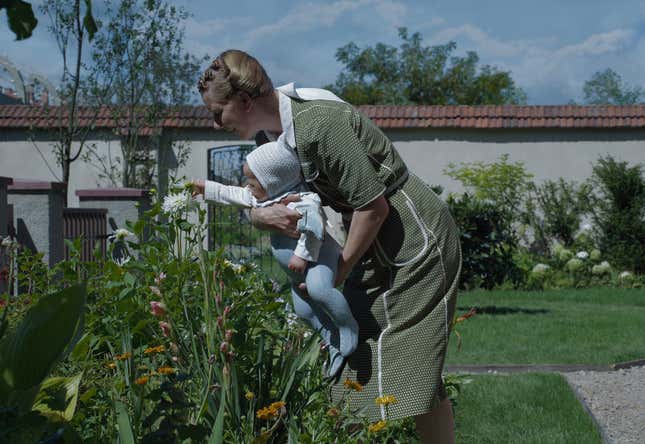
The opening shot of Jonathan Glazer’s The Zone Of Interest is a pitch-black frame into which the film’s title slowly dissipates. Depriving its audience of a visual anchor, the first few minutes of the film force you instead to listen closely to Mica Levi’s chilling score and Johnnie Burn’s eerie sound design. It asks you to sink into a world where your senses will be enveloped with a fog of a tale that’s equal parts banal and insidious. Glazer puts out a call to pay close attention, to focus on details one may otherwise miss. It’s a powerful gambit that rightly sets the tone for one of 2023’s greatest achievements, a film discomfiting in its approach to the Holocaust, and a horrifyingly mundane portrait of a man, a household, and a country.
When Glazer finally allows us to emerge from Levi and Burn’s jointly stultifying soundscape, he introduces us to the Höss family. They’re surrounded by a lush landscape. Hedwig and Rudolf (Sandra Hüller and Christian Friedel) are surrounded by their children, with whom they’re enjoying a lovely sunny day by the river. Together, in their matching bathing suits with a baby in tow, they’re a shining example of an Aryan family. There may be smiles and giggles all around but nothing about Glazer’s gaze (courtesy of Łukasz Ża’s piercingly exacting cinematography) suggests warmth. We’re to be at a remove from this family, observing them from afar even as we enter their most intimate of spaces—and even as we get to see them getting ready for school or enjoying a sweltering summer’s day, boasting of plentiful home renovations, or celebrating birthdays with wide-eyed glee. This is a chronicle of a family shot with unsparing eyes.
For Höss lives in the film’s titular zone, the euphemistic designation for the 40-square-kilometer area surrounding the Auschwitz concentration camp in Poland. There, his wife Hedwig has prided herself on building quite the cozy home—there’s a well-stocked kitchen and ample closets; there’s a beautifully manicured garden and a splash pool for the kids. It’d be a house like any other were it not in the shadow of the camp on the other side of its barbed wire fence, and surrounded, as we’re constantly made to remember with an incessant barrage of muted screams and scattered gunshots, by a place designed with only one aim in mind: death. A most efficient kind of death. An impersonal kind that Höss himself oversees and continues to optimize on any given day.
But Glazer, adapting Martin Amis’ novel of the same name, isn’t focused (solely) on Höss’ day-to-day Nazi agenda. Instead, he’s squarely set his unflinching gaze on the day-to-day occurrences at his home. Yes, we’re made privy to conversations about new patents that would make gassing hundreds of people at a time more efficient, but we’re also made to be present as the many maids Hedwig oversees pour drinks and sweep the floors. We watch, in stilled, stilted shots, as the kids turn instruments into make-believe weapons and listen in as gossip between neighbors reveals how fur coats, lipsticks, and rings make their way from the camp into the hands of those who live just outside it. We may never step foot into the camp, but The Zone Of Interest places us in such proximity to it that its harrowing reality becomes all the more inescapable given how Hedwig and her family have grown used to seeing it as mere white noise to their jolly good lives.
As an audiovisual conceit, Glazer’s decision to keep us safely ensconced in this household forces us to all the more clearly see the details that capture the intractable tragedy happening just over the wall. When, in one nighttime shot we witness Rudolf smoking a cigar as a chimney in the backdrop puffs plumes of black smoke, you’re unable to avoid the synecdoche the film is creating: the part stands in for the whole; Rudolf’s brisk bureaucratic ascension is emblematic of the “banality of evil” that Hannah Arendt so carefully outlined decades ago. The reality of the fate of the Jews Hedwig so carelessly keeps out of her mind (with Hüller making this leaden woman a frightening portrait in willful yet craven indifference) was made possible precisely because it remained so out of frame. That is, of course, until you realize it is in every frame—and drives every aspect of the Höss’ household. Not just the pantry staples they get and the used clothes they plunder, but the very ashes that feed their garden and the labor that keeps the place around them running.
The more time you spend in “the zone of interest,” the more you’re forced to bear witness. In its many wide-open shots, the better to show, perhaps, the immensity of what’s around the house, Glazer insists you notice how this well-run household captures in miniature a larger ailment. Rudolf’s brazen careerism and Hedwig’s self-serving narcissism are here not as human excuses to explain how they were mere cogs in the larger machine that was the Nazi Final Solution but as examples of how their choice to become so made them all the more inhumane. As a piece of observational cinema that borrows from the very visual grammar of nonfiction films, The Zone Of Interest is an instant classic, a masterpiece whose every gorgeously framed shot aims to stun you into silence. And into forceful remembrance as well.
The Zone Of Interest opens in select theaters December 15 and opens nationwide February 2, 2024